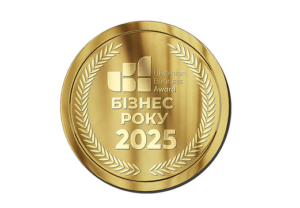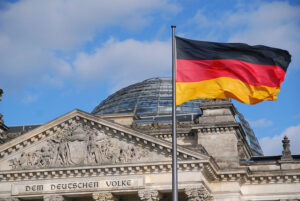
The Ukrainian Business Award is an independent award that recognizes the best companies in Ukraine for their contribution to the economy and society. The winners are selected based on objective data and expert opinions.
The award is a confirmation of Rauta’s leadership in the construction market and its contribution to the development of the Ukrainian economy, as the company continues to operate steadily, introduce new technologies and actively participate in the restoration of destroyed buildings during the full-scale invasion. Since 2022, the company has participated in the reconstruction of the Retroville shopping center, two supermarkets and the Novus logistics terminal, Forum Park Plaza in Kyiv, Pinocchio kindergarten in Bucha, and a truck service station in Odesa.

JSC OTP BANK is on the second place in several July ratings of the Settlement Center for servicing contracts in the financial markets. In particular, in the overall rating of clearing members, among clearing members in the securities market and among clearing members in the repo and foreign exchange swap markets, OTP Bank is the second. This information is published on the website of the Settlement Center. OTP Bank is a leader among banking institutions with foreign capital, and it is also ahead of several state-owned banks.
“In the first seven months of 2025, our individual clients purchased government bonds for a total amount of UAH 7.7 billion in equivalent. Up to 99% of all transactions are conducted in the banking application,” said Valeria Ovcharuk, product owner of OTP BANK.
She reminded that thanks to the OTP Bank UA application, you can invest in government bonds directly at auctions of the Ministry of Finance or buy bonds from the Bank’s portfolio 24/7, from anywhere in the world. “Among our clients, 48% go to auctions on their own, while the rest prefer to buy from the portfolio. There is a large selection, and customers can compare rates, maturities, and interest payment options as if in an online store,” said Ovcharuk.
To learn more about investing in domestic government bonds through the OTP Bank UA app, please follow the link.

On September 26, 2025, Kyiv will host the 19th Customer Experience Conference, the only cross-industry conference in Ukraine that turns conversations about customer experience into the language of systems and profit.
The leitmotif of the 2025 event is CX as a system for profit.
Against the backdrop of war, market instability, and staff fatigue, it is systemic customer centricity that is becoming a critical advantage. Companies that shape the customer experience not intuitively, but through metrics, structure, and transparency, show better capitalization, efficiency, and long-term loyalty.
What is the focus of the program?
Among the speakers:
Speakers will share transformation practices in times of turbulence, cases of CX systems implementation, and approaches to team experience design.
19′ Customer Experience Conference is a platform that helps companies move from chaotic efforts to a mature model of working with customer experience.
Who should attend:
Date: September 26, 2025
Location: Kyiv, Ramada Event Hall + Online
Event partners: Oschadbank, Kormotech, Linkos Group
Tickets and details: https://kagroup.ua/cx
Contact: info@kagroup.ua | +38 (063) 247 94 74

From September 4 to 6, 2025, Riga FOOD 2025, a key industry event in the Baltic region, will be held in Riga, Latvia. Every year, it brings together hundreds of manufacturers, distributors and buyers from many countries. In 2024, more than 400 companies from 25 countries took part in the exhibition.
This year, the Department of Industry and Entrepreneurship Development of the Kyiv City State Administration is organizing a consolidated stand “MADE IN KYIV” with an area of 36 m², where the products of leading Kyiv food producers will be presented.
Participation is free of charge for companies. This project is being implemented within the framework of the City Target Program for Promoting the Development of Industry, Entrepreneurship and the Consumer Market for 2024-2025.
Also, on September 5, the Business Forum of Ukrainian-Latvian Cooperation and the presentation of Kyiv’s export potential will be held with the participation of representatives of Kyiv and Riga city administrations, Kyiv-based manufacturers and companies from the Baltic region. The program includes presentations from both sides, b2b meetings, and the signing of cooperation agreements.
“The city systematically supports Kyiv business and, especially, its access to international markets. Our producers are competitive, and Made in Kyiv is becoming a recognizable sign of trust abroad” – said Volodymyr Kostikov, Director of the Department of Industry and Entrepreneurship Development of the Kyiv City State Administration.
The stand will feature:
Participation in Riga FOOD 2025 is an opportunity for the capital’s producers to expand exports and establish new connections. For the capital, it is a confirmation of the systematic work to support the city’s industrial potential and present Kyiv as an export and investment platform to an international audience.
Interfax-Ukraine is a media partner of the event.

PJSC “European Insurance Alliance” (Kiev) in January-June 2025 collected UAH 186.8 mln of net premiums, 48.71% more than in the same period a year earlier, as well as increased the volume of gross premiums by 35.5% – to UAH 194.05 mln.
This is evidenced by the data in the information of the rating agency “Standard-rating” on updating of the company credit rating/rating of financial stability (reliability) of the insurer at the level of “uaAA” on the national scale according to the results of the specified period.
As it is noted, receipts from individuals of the insurer for the first half of the year have grown by 75,33% – up to UAH 77,806 mln, and from reinsurers have decreased by 13,08% – up to UAH 0,412 mln. Thus, legal entities continue to prevail in the client portfolio of the company.
For six months of 2025 the company has paid out UAH 104,7 mln to clients – by 32,4% more than a year earlier.
According to RA data, as of July 2025 65,57% of the company’s liabilities were covered by liquid assets (cash, government bonds and bank deposits).
At the same time the company has formed a portfolio of financial investments, which consists of government bonds and bank deposits in the amount of UAH 124,558 mln, that positively influences its provision with liquid assets.
As of the beginning of Q3 2025, 38,91% of PJSC ‘European Insurance Alliance’ liabilities were covered by shareholders’ equity, and 4,92% of liabilities – by cash on accounts and cash equivalents.
PJSC ‘European Insurance Alliance’ has been operating in the insurance market of Ukraine since 1994. It is a member of the Auditing Commission of the MTSBU, a participant of the agreement on direct settlement of losses on compulsory insurance of civil liability of owners of land vehicles, a member of the Board of the Nuclear Insurance Pool of Ukraine.
The company provides 30 types of voluntary and compulsory insurance, including property, automobile, liability and personal insurance.

Germany is losing industrial jobs at an accelerated rate – and this is no longer a localized slump, but a steady trend. According to a fresh study by EY, the industry cut employment by 2.1% over the year, with the auto industry losing about 51,500 jobs (-6.7% year-on-year). Weak demand, expensive energy, competition from Asia, US duties and the expensive transition to electric vehicles are squeezing margins and forcing concerns to optimize staffing levels. In Q2 2025, industry revenue fell 2.1% YoY to €533bn, continuing a series of quarterly declines.
Structurally, the auto sector was the hardest hit, but contractions are also evident in mechanical engineering and metals, while chemicals and pharma are showing relative stability, as evidenced by both public excerpts from the EY barometer and industry commentary in the German business press. In aggregate, German industry has shed around a quarter of a million jobs since 2019, reflecting the cumulative effect of several consecutive shocks.
Operational metrics point to a sluggish cycle, with new orders in manufacturing falling in June and annualized turnover declining; this combination usually signifies weakness over the horizon of the coming quarters, even if individual months produce technical bounces in production. At the macro level, this is combined with a fall in GDP in Q2 and a downward revision of the dynamics of the beginning of the year.
The political backdrop has become tougher, with Chancellor Friedrich Merz openly stating that the current welfare state model is “unfundable” without reforms, signaling a possible shift in budget priorities in favor of incentives for employment and industrial competitiveness. For business, this means less room for “inertia” subsidies and more pressure on productivity, R&D and export adaptation.
What this means for companies and the labor market. Automakers and their supply chain will likely face a second wave of restructuring to accommodate the EV economy and US tariff geopolitics; engineering will continue to lose low-margin positions to Asian competitors, and growth will shift to high-engineering value-added niches. For chemicals and pharma, the window of resilience is preserved through contractual models and pricing power, but energy-intensive segments remain vulnerable to spot gas and electricity disruptions. The labor market will be “two-speed”: release on the assembly line and in basic metalworking in parallel with a shortage of specialists in automation, electronics, software, battery technologies and chemical technologies – this is already evident in the structure of vacancies and industry surveys.
Conclusion. The job cuts are not the “end of industry” but a painful realignment: Germany is losing mass jobs where it is losing out on costs and is trying to retain and grow employment in capital- and knowledge-intensive segments. The key to a turnaround is cheaper energy, faster permitting procedures, prioritization of industrial investments and retraining for the electric and digital agenda. In the meantime, order and turnover statistics signal that the bottom of the cycle has not yet been passed.
https://t.me/relocationrs/1332